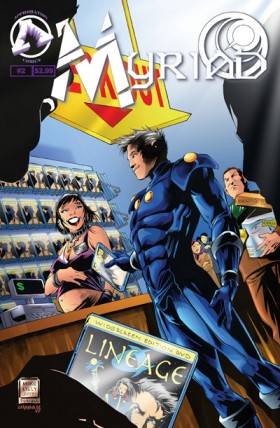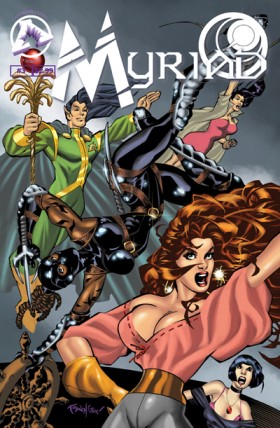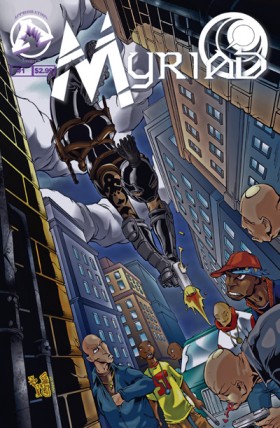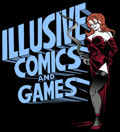| Small
Pressed: Myriad #1-3
 While
I usually lend my reviews to the topic of graphic novels,
I’ve decided to expand my repertoire and review some
single issues from a comic company that is a part of the
smallest part of our comic book press. While
I usually lend my reviews to the topic of graphic novels,
I’ve decided to expand my repertoire and review some
single issues from a comic company that is a part of the
smallest part of our comic book press.
Approbation
is a company with a self-proclaimed mission to “bring
comics to a wider, more mainstream audience,” and
to “shatter old stereotypes of what this industry
is about and can offer to the rest of the world.”
At current, they publish three distinct lines of comics:
the gothic horror based Vampire Universe comics, the Alpha
Universe which features superheroics, and the single title
Myriad. This strive to bring more diversity to
comics seems to be the impetus for Myriad, which
is an anthology title carrying five separate stories, each
story getting a few pages of plot each issue. Anthology
comics are hard to pull off, as the shortness of story-space
and the jumping from one story to the next sometimes becomes
tiresome, so immediately Approbation should score some points
for the attempt.
The
collection of stories here does actually cover a swath of
genres; “Chi Sai” is an urban flavored tale
of vigilantism, while “Lineage” is a straight
science fiction tale with flecks of fantasy genre. “Discount
Stories” is a day-in-the-life series that covers the
malaise of a group of retail workers. “The Adventures
of the Molly Be Damned” is a high-seas pirate adventure,
as the name might suggest, and “Frail,” by far
the most intriguing series, is something that almost escapes
explanation, mixing non-traditional storytelling techniques
with excellent elements of thriller/horror writing.
While
the mix of genres makes the range of appeal for the book
grow extensively, the quality of the stories also runs the
gamut from very good to utterly unreadable, whether being
the fault of poor writing or artwork that needs extensive
polishing.
The
worst of the bunch are actually the genres that usually
sell well in the comic book market: “Lineage”
with its sci-fi bent, and the “…Molly Be Damned.”
“Lineage” suffers from a somewhat boring premise
(the future world of technology is invaded by elves and
a magic forest) and poor concept plotting by creators Jay
Jacobs and Chris Tsuda. The dialogue the characters spout
is stale and the writers try to insert sarcasm and banter
through one of their main characters to little effect.
In addition,
the artwork by Tsuda is in need of some anatomical work.
There are times when their character’s lower extremities
shrink ridiculously in proportion to the upper torso, not
to mention the actions and movement of the characters are
drawn distorted.
 The
“Molly Be Damned” is actually much worse. Writer
Richard Nelson concocts a nearly incomprehensible pirate
story that jumps around and leaves the reader with no characters
to focus on, no plot points to anchor to, and no real frame
with which to understand the story. We jump forward and
back in time within the space of a panel, which does not
help the confusion, and bad dialoguing and a lack of personality
make his characters cookie-cutter. The artwork here is dreadful.
Eli Ivory and Brian Laframboise seem at a loss when drawing
the human body and its dimensions, I think because they
are trying to adopt some type of signature style. They do
not ink the work well enough to add definition or depth
to the characters, nor do they provide detailed backgrounds.
The end result is some thin lined characters occasionally
covered with a field of black, with stark and bare backgrounds,
making the comic as visually unappealing as one could make
it. The
“Molly Be Damned” is actually much worse. Writer
Richard Nelson concocts a nearly incomprehensible pirate
story that jumps around and leaves the reader with no characters
to focus on, no plot points to anchor to, and no real frame
with which to understand the story. We jump forward and
back in time within the space of a panel, which does not
help the confusion, and bad dialoguing and a lack of personality
make his characters cookie-cutter. The artwork here is dreadful.
Eli Ivory and Brian Laframboise seem at a loss when drawing
the human body and its dimensions, I think because they
are trying to adopt some type of signature style. They do
not ink the work well enough to add definition or depth
to the characters, nor do they provide detailed backgrounds.
The end result is some thin lined characters occasionally
covered with a field of black, with stark and bare backgrounds,
making the comic as visually unappealing as one could make
it.
Of better
quality are “Chi Sai” and “Discount Stories.”
Bart Thompson writes a somewhat brief but intriguing story
about revenge at the street level, with a Kevlar covered
vigilante with connections to organized crime. There are
times when his dialogue is forced, mostly in the scenes
where a random thug might be speaking, and the story is
not anything the casual comic reader hasn’t seen before,
but the silence of his main character and her origin makes
her more captivating to the reader.
Of real
note though is the artwork by Steve Fox; his panel work
is all done in un-inked pencil. Fox seems to use several
lead weights to shade in and texturize his environments
and characters, and it’s very eye-catching. Fox does
tend to overdo the facial shading, at times making his thugs
look like hairy dog-men, but the style really does work
well with Thompson’s story. Fox’s artwork seems
to improve each issue, getting very good in the third issue,
during a family moment involving the main character where
he uses it to intone some somberness and muted threat.
“Discount
Stories” is the story that looks like it’s from
the small press. Thin, possibly only pencil done over with
pen, shaky lines drawing characters that aren’t really
easy to look at, but manage to be usable to tell a story.
Writer John P. Ward takes each issue and tells the story
of a different employee of the retail store they inhabit.
Ward makes up for the somewhat, and seemingly purposeful,
grotesque art of Steve Doty, with a very character driven
short story each issue, whether it be the old and disgruntled
greeter, the pregnant cashier, or the two pleasant women
who secretly hate each other. Ward knows how to pace his
story and to build it slow, even with the limited amount
of space he’s allotted, making the reader care about
both plot and character. And even though Doty’s art
is shaky, the uncertain quality of it seems to echo the
point of themes of the series.
 The
best story in the three issues I perused is by far “Frail”
by writer Christopher J. O’Bryant and artists Jason
Hazel, Jason Sandman and Brian Laframboise (Issues 1-2),
as well as Rich Molinelli and Joseph Armour (Issue 3). O’Bryant
begins in issue one with a date between two people that
ends horrifically, which is the first domino to fall in
his plotted series. Each issue after the first has everything
to do with the issue before it, but not because there is
an overarching plot that links them. Instead, the writer
has found a way to string together disparate stories in
such a way that they both depend on each other, while being
able to read them separately. He manages to throw twists
into his plot that are not expected and surprising every
time, which is odd because it usually ends up being the
same action, only come at from an entirely different direction. The
best story in the three issues I perused is by far “Frail”
by writer Christopher J. O’Bryant and artists Jason
Hazel, Jason Sandman and Brian Laframboise (Issues 1-2),
as well as Rich Molinelli and Joseph Armour (Issue 3). O’Bryant
begins in issue one with a date between two people that
ends horrifically, which is the first domino to fall in
his plotted series. Each issue after the first has everything
to do with the issue before it, but not because there is
an overarching plot that links them. Instead, the writer
has found a way to string together disparate stories in
such a way that they both depend on each other, while being
able to read them separately. He manages to throw twists
into his plot that are not expected and surprising every
time, which is odd because it usually ends up being the
same action, only come at from an entirely different direction.
It’s
very well written, and the interaction between the characters
is believable. That might be O’Bryant’s best
feature: that he writes his characters invariably realistically,
making them human to the reader in a matter of pages. The
artwork works very well with the story, though the constant
changing of the artistic staff might need to be addressed.
Issue 2, from Hazel and Laframboise was especially good,
as the artists helped to make a simple psychiatric session
seem utterly chilling when paired with O’Bryant’s
skillful word choice.
Myriad
is an anthology that covers both the bad and the good of
comics. Unskilled artwork and the inability to create believable
characters grace its pages, while at the same time, work
of great artistic caliber and a keen knowledge of story
construction is also present. It’s a comic that definitely
lives up to its name. Whether or not it fulfills the companies
mission statement is something best left to future debate.
If you
would like to see more of Myriad or to check out other titles
from this company, go to Approbation
Comics Online.
|
 While
I usually lend my reviews to the topic of graphic novels,
I’ve decided to expand my repertoire and review some
single issues from a comic company that is a part of the
smallest part of our comic book press.
While
I usually lend my reviews to the topic of graphic novels,
I’ve decided to expand my repertoire and review some
single issues from a comic company that is a part of the
smallest part of our comic book press.
 The
“Molly Be Damned” is actually much worse. Writer
Richard Nelson concocts a nearly incomprehensible pirate
story that jumps around and leaves the reader with no characters
to focus on, no plot points to anchor to, and no real frame
with which to understand the story. We jump forward and
back in time within the space of a panel, which does not
help the confusion, and bad dialoguing and a lack of personality
make his characters cookie-cutter. The artwork here is dreadful.
Eli Ivory and Brian Laframboise seem at a loss when drawing
the human body and its dimensions, I think because they
are trying to adopt some type of signature style. They do
not ink the work well enough to add definition or depth
to the characters, nor do they provide detailed backgrounds.
The end result is some thin lined characters occasionally
covered with a field of black, with stark and bare backgrounds,
making the comic as visually unappealing as one could make
it.
The
“Molly Be Damned” is actually much worse. Writer
Richard Nelson concocts a nearly incomprehensible pirate
story that jumps around and leaves the reader with no characters
to focus on, no plot points to anchor to, and no real frame
with which to understand the story. We jump forward and
back in time within the space of a panel, which does not
help the confusion, and bad dialoguing and a lack of personality
make his characters cookie-cutter. The artwork here is dreadful.
Eli Ivory and Brian Laframboise seem at a loss when drawing
the human body and its dimensions, I think because they
are trying to adopt some type of signature style. They do
not ink the work well enough to add definition or depth
to the characters, nor do they provide detailed backgrounds.
The end result is some thin lined characters occasionally
covered with a field of black, with stark and bare backgrounds,
making the comic as visually unappealing as one could make
it. The
best story in the three issues I perused is by far “Frail”
by writer Christopher J. O’Bryant and artists Jason
Hazel, Jason Sandman and Brian Laframboise (Issues 1-2),
as well as Rich Molinelli and Joseph Armour (Issue 3). O’Bryant
begins in issue one with a date between two people that
ends horrifically, which is the first domino to fall in
his plotted series. Each issue after the first has everything
to do with the issue before it, but not because there is
an overarching plot that links them. Instead, the writer
has found a way to string together disparate stories in
such a way that they both depend on each other, while being
able to read them separately. He manages to throw twists
into his plot that are not expected and surprising every
time, which is odd because it usually ends up being the
same action, only come at from an entirely different direction.
The
best story in the three issues I perused is by far “Frail”
by writer Christopher J. O’Bryant and artists Jason
Hazel, Jason Sandman and Brian Laframboise (Issues 1-2),
as well as Rich Molinelli and Joseph Armour (Issue 3). O’Bryant
begins in issue one with a date between two people that
ends horrifically, which is the first domino to fall in
his plotted series. Each issue after the first has everything
to do with the issue before it, but not because there is
an overarching plot that links them. Instead, the writer
has found a way to string together disparate stories in
such a way that they both depend on each other, while being
able to read them separately. He manages to throw twists
into his plot that are not expected and surprising every
time, which is odd because it usually ends up being the
same action, only come at from an entirely different direction.





